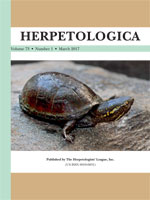Intraspecific variation in behavior is often associated with age or size class, with many animals experiencing ontogenetic differences in diet, predation risk, physiological function, and competition. The nature of intraspecific behavioral variation will depend on the environmental context and has been more thoroughly examined for diurnal species. We studied microhabitat use and activity relative to time of night and the lunar cycle for the nocturnal gecko Chondrodactylus turneri, in the Namib Desert. Geckos preferred larger rocks with more crevices and were clumped in their occupancy of rocks, with some rocks being occupied by as many as eight individuals. Age classes differed in their use of open areas, with juveniles being encountered more often in the open. Activity levels varied with moon phase and time, with adults and juveniles exhibiting different relationships. Our results indicate that multiple factors might be influencing intraspecific behavioral variation.
How to translate text using browser tools
1 March 2017
Habitat Use and Activity Patterns in the Nocturnal Gecko, Chondrodactylus turneri
Maria A. Eifler,
Rheana Marchand,
Douglas A. Eifler,
Keoleboge Malela
ACCESS THE FULL ARTICLE

Herpetologica
Vol. 73 • No. 1
March 2017
Vol. 73 • No. 1
March 2017
behavior
ecology
lizard
lunar cycle
Morphometrics
Namib Desert
Turner's Thick-toed Geckos




